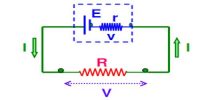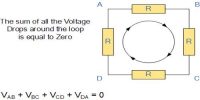We know, the electric current is the flow of charges through a material. This electric current can move very easily through some substance. There are some mediums through which electricity cannot move at all. Solid materials are classified into three groups depending on their electricity conduction. For example – (1) conductor (2) insulator (3) semiconductor.
![]()
- Insulator
The materials through which electric current cannot flow are called insulators. They possess no free charge carriers and thus are non-conductive. Therefore, the materials where electrons are not free to move about are the insulators. They are the elements which do not consent to any flow of electric accusation. For example Plastic, rubber, wood, glass, etc. There are no free electrons inside insulating materials. Electrons do not flow easily through plastic type materials. As a result, plastics are an insulator for electricity. The valence band and conduction band are divided by the energy band gap of 6eV. Thus electrons do not move from valence band to conduction band under the influence of any thermal agitation.
The atomic bond: It is based on shared electron pairs of nonmetals. The elements which behave like nonmetals have the craving to catch electrons, thus there are no free electrons which may serve as charge carriers.
The ionic bond: In the solid state, ions are arranged in a grid network. By electrical forces, the particles are held together. There are no free charge carriers to enable the current flow.
Due to this, the handles of screwdrivers and pliers used by electricians are covered with plastic type materials In addition, the copper wires which we use in our daily needs are covered with plastic.
Example: Wood, Rubber, Glass, Ebonite, Mica, Sulphur, Dry air.
- Conductor
The materials through which electric current can flow very easily are called conductors. They are usually substances which have the property to pass dissimilar types of energy. Electrons can flow freely within these materials. In metal wires, the charges are carried by electrons. So, metallic materials are good conductors of electricity. They are the elements which consent to the flow of electric current through it by the function of voltage. Copper, silver, aluminum, etc. are good conductors. Due to this reason, metallic wires are used as electrical connectors. Conductors are having a positive temperature coefficient of resistance. The resistivity of the conductor is given as 10-8 Ohm/cm.
Example: Copper, Mercury, Silver, Al, Water, Acids, Human Body, Metallic Salt, Charcoal.
- Semiconductor
The materials whose current conduction capacity lies between that of conductors and insulators in normal temperature are called semiconductors. They are solids whose conductivity lies between the conductivity of conductors and insulators. For example- germanium, silicon, etc. They are the elements whose conductivity lies between insulators and conductors. The current conduction capacity of the semiconductor can be increased by adding suitable impurities. At absolute zero temperature, the semiconductor behaves like an insulator whereas by providing thermal agitation, the charge carriers start moving from valence band to conduction band.
Due to the exchange of electrons – to achieve the noble gas pattern – semiconductors arrange as a lattice structure. Unlike metals, the conductivity increases with increasing temperature.
Example: Germanium, Silicon, Cotton, Wool, Marble, Sand, Paper, Ivory, Moist air.











